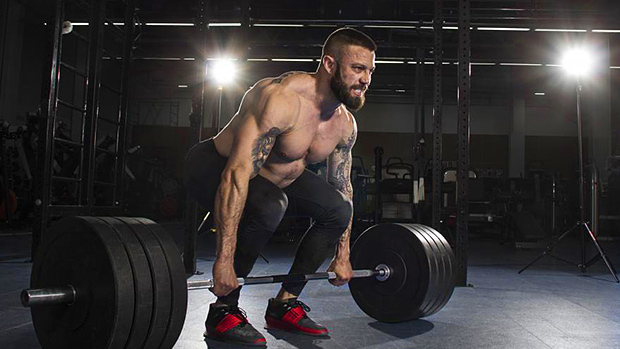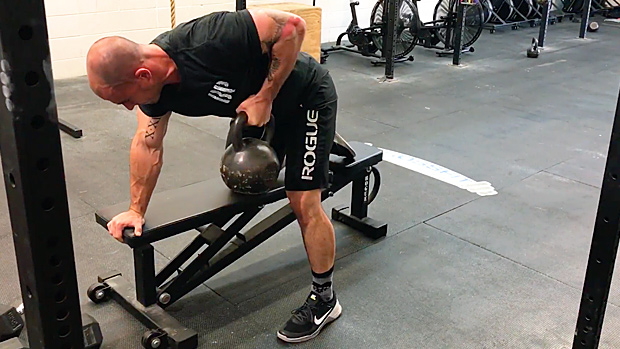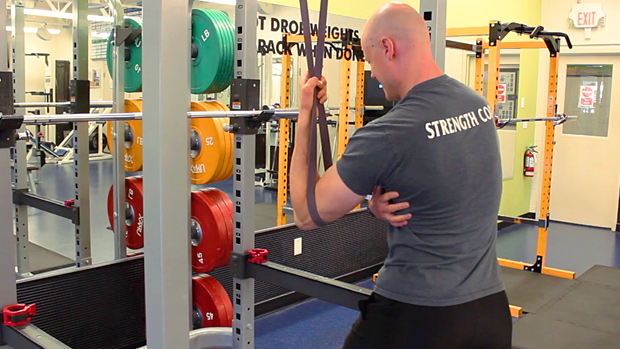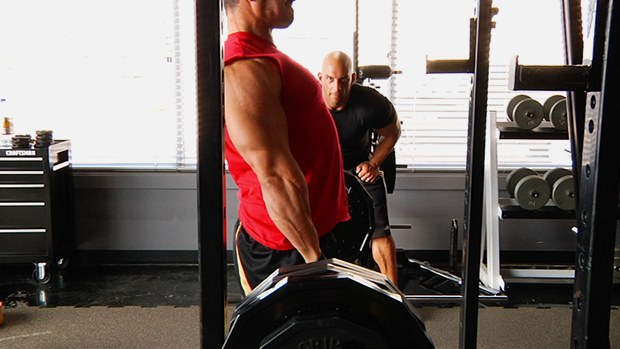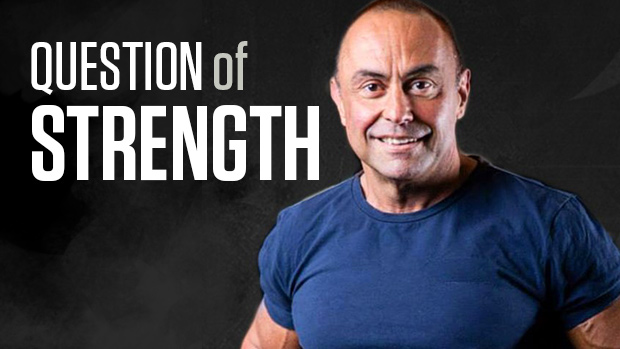Experts say it's wise in these tough economic times to have a resume that shows diversity and a wide array of skills as opposed to concentrated focus in one single area.
Clearly, Tim Henriques isn't concerned about his current employment options.
His resume can be summed up in one word: training. Henriques has served as strength coach for many collegiate teams, holds certifications in personal training, nutritional consultant, and coaching, and is now the director of the National Personal Training Institute of Virginia. He also holds the USAPL VA state deadlifting record of 700 lbs at 198.
He's 100% iron head and damn proud of it.
Henriques' almost narrow-minded training focus even extends into how he trains. He believes, above all else, in lifting weights to get bigger and stronger. Functional training, kettlebells, and Bosu balls might still have a place in his gym, but it's a really small place, tucked in the back of the bathroom in that one stall nobody uses, wedged in behind the toilet tank.
If you hope to learn the latest ways to entertain a personal training client then this article is going to suck like a Hoover, but if you want to add plates to your lifts and pounds to your frame, give Tim's Training Tips a serious read.
I believe the number one problem facing male and female trainees is that they undervalue strength. It doesn't matter whether you're trying to lose weight for a fight or tone up to fit into your wedding dress, these goals are much easier to achieve when you're strong.
Why is this? In physiology, there's a term called the Minimal Essential Strain for bone growth, which means there's a minimum threshold of weight one must cross to build bone. After training literally thousands of men and women, I believe this same principle applies to muscles, tendons, etc.

So in practical terms, a female trainee may say she just wants to "tone up," but using baby weights for high reps generally does next to nothing. The first thing even the most "bulk-a-phobic" female subject needs to do in the gym is get moderately strong, and that means progressive resistance with significant poundages until a decent base level of strength is reached. It's only at that point that specializing with comparatively light loads and higher reps might actually accomplish something.
In other words, curling a 5-pound dumbbell for 20 reps will do essentially nothing aesthetically to an arm, but curling a 20-pound dumbbell for 20 reps is another matter entirely.
So just how strong is "a decent base level of strength?" I have standards that I use for men and women; refer to this article for the details. Male or female, you should make reaching "Good" or at least "Decent" strength levels your top priority, regardless of the end goal.
This means you should be able to use approximately equal weight in your strongest chest exercise (usually the flat bench press) and your strongest lat exercise (usually a 45-degree bent over row or a chin-up, bodyweight included). This helps with overall fitness and it helps keep the shoulder girdle injury free.
If you read this tip and thought there's no way in hell you can chin or row what you bench, then it's safe to say where your programming emphasis should be.
It doesn't matter if we're talking triceps, calves, or pecs, you need to get inside the muscle mid-set and feel them working. I know it sounds like Weider-wisdom, but it works.
For example, "pullover" skullcrushers for triceps, seated leg curls for hamstrings, and donkey calf raises are all superior to triceps pressdowns, lying leg curls, and seated calf raises, respectively.
While they're all decent exercises, it just boils down to risk versus reward, and I can't justify performing a potentially injurious exercise when there are other, safer alternatives that are just as effective. And yes, I realize that many of you can perform these exercises pain-free today, but to me it's like smoking: Talk to me in 10 years.
So what are better alternates? EZ bar curls or straight bar curls performed on the preacher bench (less wrist strain); dumbbell shoulder presses, military presses, and front lat pulldowns in place of the behind the neck variations; shrugs or lateral raises for upright rows.
Chronic elbow, shoulder, and knee pain always benefits from decreased exposure.
Okay smart ass, I'm not saying, "If an exercise hurts, duh, don't do it." I'm saying to begin by training the area less frequently before you start completely removing otherwise effective exercises from your program.
For example, if your shoulders are hurting and you currently train chest and shoulders once a week, each on separate days, start by pairing chest and shoulders together to essentially cut your shoulder exposure in half. This way you can still reap the benefits of training them, but double their recovery time.
The second thing you should do is take fish oil Actually, you should be taking fish oil to begin with.
You can't train your lower body without involving your lower back; they're essentially inseparable, so either do squats and deadlifts on the same day or separate them by 3 to 4 days.
Why? Because when you're significantly strong, you do a lot of damage to the area every time you train it, and that damage usually requires more than two days to heal.
Training with heavy loads combined with high frequency is a recipe for joint and tendon disaster, so most strong people should train with a frequency of once or twice a week, especially for the big stuff.
Of course, if you're strong you probably know this already, but if you're sitting in front of your computer scoffing at this tip, saying that you have no problems benching on Mondays, Wednesdays, and Fridays, then you and I probably have vastly different standards of what strong is in the first place.
You can get away with hitting the forearms or calves multiple times per week with high reps, but good luck getting away with that with chest or hamstrings. It's the same with larger athletes: you can make a 185-pound defensive back do sprints for an hour, and while they certainly won't like it, they'll survive. Try doing that with an offensive lineman--he'll die. There is an inverse relationship between the size of the muscle (or athlete) and training volume.
I firmly believe that training with a partner boosts Testosterone and I also realize that I have zero scientific evidence to back up that claim. It could be that the benefit of the partner is simply motivational, but I still think my explanation sounds cooler. Bottom line, it works.
You'll learn more than if you read 25 fitness books once. Back in the day there weren't that many books available, so guys read the few they had over and over again and really absorbed the material. Today, you could read a different "fitness" book every day for the next five years. How much info do you think you absorb that way?
Here are my five favorites to get you started:
- Supertraining by Siff and Verkhoshansky
- Science and Practice of Strength Training by Zatsiorsky
- Stretching Scientifically: A Guide to Flexibility Training by Kurz
- Science of Sports Training: How to plan and control training for Peak Performance by Kurz
- Starting Strength by Rippetoe
I just realized they all begin with S. Oh well.
If you can only afford one, get Starting Strength. Actually, get Supertraining; you can easily read that one 25 times and still learn something.
One of my favorite quotes is, "Don't listen to someone tell you how to squat or follow their squat program if they can't perform a decent squat themselves." Another favorite is the politically incorrect but painfully logical, "Never listen when someone fat talks about nutrition." It's common sense.
I can hear the hate mail already starting to fly from readers who know plenty of smart guys who aren't strong or in shape. I'm sure you do. But there are plenty of people who are very knowledgeable but also look great and/or are very strong; why follow those who don't have the passion to follow their own advice?
Conditioning is very option-friendly: Prowler, sled dragging, complexes, jump rope, med ball stuff, kettlebells, tires, sandbags, sledgehammers, etc. They're all possible options and they're all as hard as you make them. Anyone who uses the treadmill exclusively has a serious case of self-loathing.
What I like to do is to pick 2-4 conditioning exercises and rock them out each conditioning workout. Here's a sample for those with no imagination:
- Barbell Complexes: (Just pick one. There's been about a thousand published at Testosterone alone). Perform 3 sets of 8 with a one-minute rest;
- Kettlebell swings: 10, 10, 20, 20, 30 reps (drop weight when the reps increase) with a one-minute rest;
- Sandbag carry: 70 lbs for 60 yards, 5 trips total, with a one-minute rest. (I like to carry the sandbag in this order: 1) Over Right Shoulder, 2) Biceps carry, 3) Over Left Shoulder, 4) Biceps Carry, 5) Around neck.
Done. Stretch if you wish and go home, secure in the knowledge that your conditioning needs don't require equipment with electrical plugs, TV screens, or mini-fans to cool you in the unlikely event you break a sweat.
Most training and conditioning breaks the body down. But brisk walking restores the body and calms the mind. As a bonus, it also burns calories and can help you drop fat fast, especially when you perform it fasted. (Oops, now I've said it.)
I'll be honest, at first I was a bit freaked out by them, and even though we had a pair of inversion boots in our gym, I didn't use them for a few years. Now I'm seriously regretting that. I tried them out about six months ago and loved them, so these days I try to do them at least once a week.
However, you'll most likely need to be following tip #10; once you're tired it can be very difficult to get out of the hanging position by yourself, and depending upon what part of town you're in or your own personal "style," dangling by your ankles may not be the wisest move. But to each their own.
Here's what it looks like:
- Vitamin A: 25000 units
- Vitamin D: 4000-5000 units
- Vitamin C: Natural preferred 100-200 mgs/min + 4000 mg of ascorbic acid
- Vitamin E: 1200 units
- Thiamin, B1: 100 mgs
- Riboflavin, B2: 60 mgs
- Niacin, B3: 100 mgs
- Pyridoxine, B6: 200 mgs
- Pantothenic Acid, B5: 100 mgs
- Folic Acid: 5 mgs
- Biotin: 100 mcg
- B12: 500 mcg
- PABA: 100 mcg
- Inositol: 500 mcg
- Choline: 500 mcg
- Calcium: 2 grams total (Calcium gluconate or calcium lactate better)
- Phosphorus: 4 grams max (1:1.5 - 1:2 of calcium)
- Magnesium: 1 gram (1:2 to calcium)
- Potassium: 5000 mg (about equal with sodium)
- Sodium: <10000 mg
- Chlorine: 10000 mg
- Copper: 5 mg
- Zinc: 1 mg
- Cobalt: 5 mg
- Iron: 15 mg
- Iodine: .15 mg
- Manganese: 10 mg
They're among the most positive, motivating fitness events you can attend.
What makes powerlifting so incredibly positive is that it isn't just about who's benching the most or who's the best lifter. Each lifter is striving to do his/her best at that moment, and it's a refreshing contrast from some other sports where it's all about being first and beating the guy next to you. Powerlifting truly is a brotherhood.
Another thing I love about powerlifting meets is that the competitors on the podium are often as diverse as the spectators in the audience. There are males, females, 15-year-old kids, 50-year-old bad asses, little dudes, big dudes, and every shape, size, age, and ethnicity in between. If you ever wanted to attend an athletic event and find yourself saying, "Hey, that could be me up there!" then find a local powerlifting meet. You won't be disappointed.
I love bodybuilding, and I love seeing the one-name super freaks like Ronnie and Jay, but I admit I get more inspired by the natural pros simply due to attainability. I train natural, and while I don't begrudge anyone who chooses not to, if I were to judge my progress against the top assisted bodybuilders it would be seriously demotivating.
Besides, have you seen what some of the top natural physiques look like these days? Wow!
(I can hear the "But what is natural?" debate starting to heat up but please, let's save that debate for another day!)

